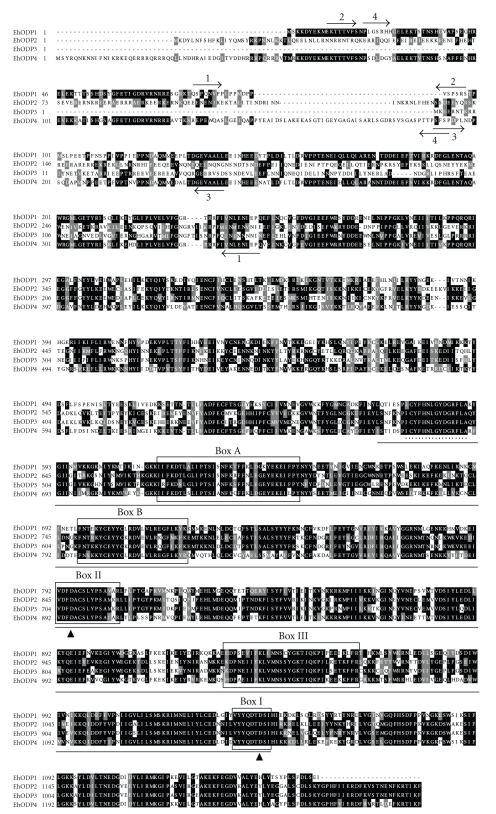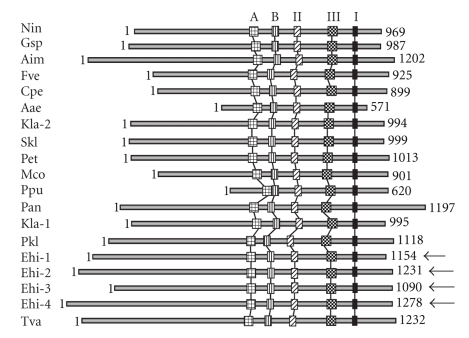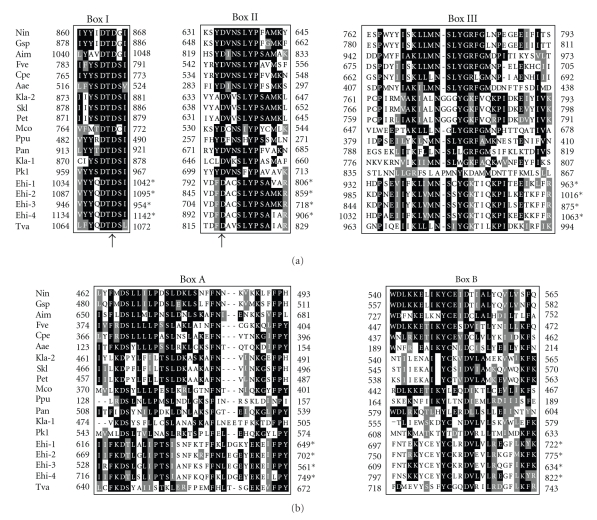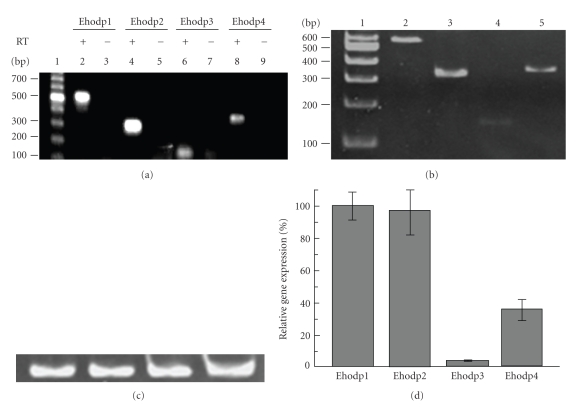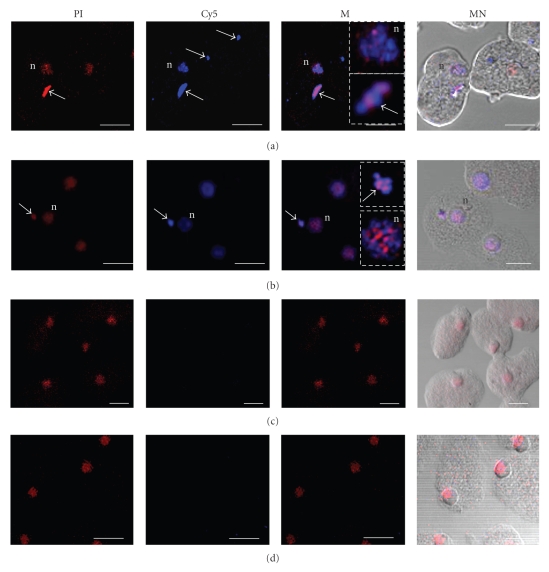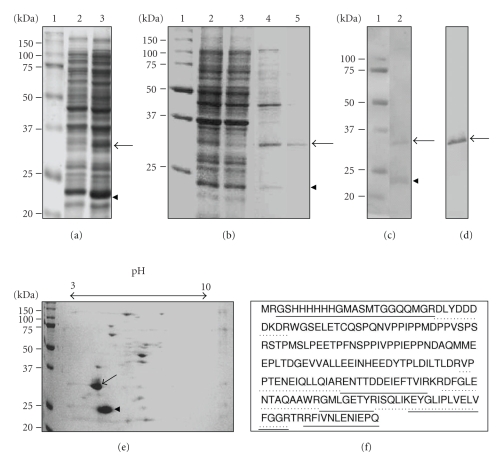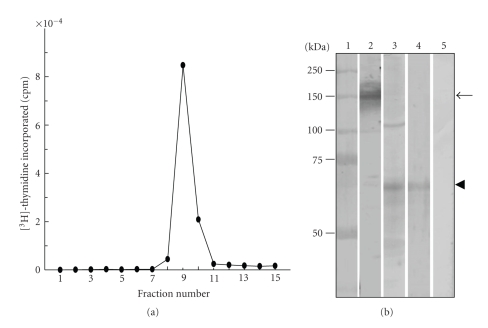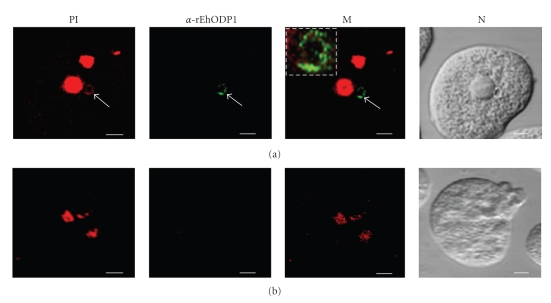Abstract
We report the identification of a family of four active genes (Ehodp1, Ehodp2, Ehodp3, and Ehodp4) encoding putative DNA polymerases in Entamoeba histolytica, the protozoan parasite responsible of human amoebiasis. The four Ehodp genes show similarity to DNA polymerases encoded in fungi and plant mitochondrial plasmids. EhODP polypeptides conserve the 3′-5′ exonuclease II and 5′-3′ polymerization domains, and they have the I, II, and III conserved boxes that characterize them as DNA polymerases of family B. Furthermore, we found in EhODP polymerases two novel A and B boxes, present also in DNA polymerases encoded in fungi mitochondrial plasmids. By in situ PCR, Ehodp1 gene was located in nuclei and in DNA-containing cytoplasmic structures. Additionally, using polyclonal antibodies against a recombinant rEhODP1-168 polypeptide, and confocal microscopy, EhODP1 was located in cytoplasmic DNA-containing structures.
1. Introduction
Entamoeba histolytica is the protozoan parasite causative of human amoebiasis [1]. Replication in E. histolytica is inhibited by aphidicolin [2, 3], a specific inhibitor of mammalian α, δ and ε DNA polymerases. Additionally, EhMCM2, EhMCM3 and EhMCM5 genes, whose products are part of the helicase complex, have been cloned and characterized [4, 5]. Although nuclear α and δ DNA polymerase sequences are present in E. histolytica genome [6], DNA polymerase encoding genes have not been isolated or characterized and DNA replication processes are poorly understood in this parasite.
In eukaryotes, replicative DNA polymerases are grouped in two families: (1) family A, which includes γ DNA polymerases of animals and fungi, and Pol I-like DNA polymerases responsible for mitochondrial DNA replication in plants and slime mold. (2) family B comprises the α, δ and ε DNA polymerases involved in nuclear DNA replication [7–9], archaebacterial, viral, bacteriophage DNA polymerases such as those present in phages T4 and RB69 and DNA polymerases encoded in fungi and plant mitochondrial plasmids [10]. Commonly, the fungal plasmids are linear and they have been frequently found in filamentous fungi [11]. Transcription and replication of linear plasmids are initiated in terminal inverted repeats by a plasmid encoded phage-like single subunit RNA polymerase and by a DNA polymerase of the family B, respectively [12]. Replication in these plasmids is thought to occur by a protein-primed mechanism, similar to that described for Bacillus subtilis phage phi29 [13]. The B DNA polymerases are distinguished by the presence of up to six common regions in their amino acid sequences (boxes I to VI). The most conserved regions (I and II) include aspartic acid residues essential to catalytic polymerase activity [10].
Although it has been reported that E. histolytica had a secondary mitochondrial lost [14], no genes encoding γ DNA polymerase responsible for mitochondrial DNA replication have been detected [6]. However, trophozoites carry mitosomes, a mitochondrial cytoplasmic remnant organelle lacking DNA [15, 16], and crypton and EhkO [17–20], two DNA-containing cytoplasmic organelles, with a double membrane. Crypton is a 0.5 to 1 μm organelle that carries the mitochondrial chaperonin Hsp60 [17, 18], whereas EhkO varies from 0.5 to 5 μm and it has the EhPFO enzyme [21]. Some authors have suggested that crypton and EhkO could be the same structure [18]; however, their morphological and biochemical characteristics need to be better studied to define this.
The mechanism of DNA replication and the proteins and genes involved in this process in E. histolytica are unknown. To better understand the DNA replication process in this parasite we have initiated the search and study of its DNA polymerase genes. Here, we report the identification of a gene family (Ehodp1, Ehodp2, Ehodp3 and Ehodp4) encoding putative E. histolytica DNA polymerases. All of them correspond to the family B, with a high similarity to fungi and plant DNA polymerases encoded in mitochondrial plasmids. RT-PCR experiments indicated that the four genes are expressed in trophozoites. Additionally, in situ PCR assays demonstrated that Ehodp1 gene is located in nuclei and in cytoplasmic DNA-containing structures. By confocal microscopy using polyclonal antibodies against a recombinant EhODP1 fragment, the EhODP1 polypeptide was only detected in cytoplasmic structures, but not in nuclei.
2. Materials and Methods
2.1. E. histolytica Cultures
Trophozoites of E. histolytica clone A were axenically cultured in TYI-S-33 medium at 37°C and harvested during the exponential growth phase as described [22]. For purification of EhkOs, the medium was supplemented with 2 μCi/mL [methyl-3H]-Thymidine (Amersham) for 48 hours [23].
2.2. Search of Genes Encoding DNA Polymerases in the E. histolytica Genome Databases
To identify a DNA polymerase encoding gene, a BLAST search was performed in the E. histolytica genome databases at The Sanger Institute http://www.sanger.ac.uk/ and Pathema from The J. Craig Venter Institute http://www.jcvi.org/. As query, we used the polypeptide sequence of the Gelasinospora sp DNA polymerase encoded on mitochondrial plasmids [UniProt Knowledgebase (UniProtKB)/TrEMBL accession number (AN) O03684] and the WU-BLAST version 2.0 program and BLOSUM62 matrix. DNA sequences were translated to proteins with the Translate tool at the ExPASy Proteomics Server http://www.expasy.org/. BLAST search for each EhODP polypeptide sequence was done with BLASTP 2.2.14 algorithm in the UniProtKB at the ExPASy Proteomics server of the Swiss Institute of Bioinformatics using the BLOSUM62 matrix. Alignments were performed with ClustalW version 1.83 algorithm at the European Bioinformatics Institute (EBI, http://www.ebi.ac.uk/Tools/clustaw2/index.html).
2.3. Semiquantitative RT-PCR Assays
Total RNA was isolated with TRIzol (Invitrogen). cDNA was synthesized with 200 U of SuperScript II reverse transcriptase (Invitrogen) and 40 U of RNasin ribonuclease inhibitor (Promega). PCR assays were performed with 3 μL of cDNA mixture, 400 μM dNTPs, 2 mM MgCl2, 200 nM of specific primers for each gene and 4 U of Taq DNA polymerase (Invitrogen). For Ehodp1 gene we used odp1-f (forward), 5′-GAAGATCTGCCAATCCCCACAAAACGTCCCAC-3′, and odp1-r (reverse), 5′-GGAATTCTTATTGCGGTTCGATATTTTCTAAGTT-3′ primers (Tm of 59°C), containing the BglII and EcoRI restriction sites at their 5′ ends, respectively. For Ehodp2 gene we used the primers odp2-f, 5′-ATCGTCGAAATACAAGACAAAA-3′ and odp2-r, 5′-TCTTTGATATTCTTCATCACTGG-3′ (Tm of 54°C). For Ehodp3 gene we used odp3-f, 5′- TGAAAGAAGAGAGAAATACAAAG -3′ and odp3-r, 5′-ATCACTAACTCTTTCTTCCCC-3′ primers (Tm of 54°C). For Ehodp4 we used odp4-f, 5′-ATCTGACTTAGATGGCTATGCTGA-3′, and odp4-r, 5′-GTCATTAAGGGGATCTGGTG-3′ oligonucleotides (Tm of 54°C). As an internal control, we used (sense) 5′-AGCTGTTCTTTCATTATATGC-3′ and (antisense) 5′-TTCTCTTTCAGCACTAGTGGT-3′ actin oligonucleotides (Tm of 54°C). PCR conditions were; 94°C (5 minutes), followed by 29 cycles at 94°C (30 seconds), annealing at specific Tm for each pair of primers (60 seconds) and extension at 72°C (60 seconds). RT-PCR products were separated by 6% PAGE gels in 0.5 × TBE (90 mM Tris, 90 mM H3BO3, 2 mM EDTA, pH 8.3), stained with ethidium bromide and visualized with a UV transilluminator (Gel Doc Documentation System, Bio-Rad). For densitometry analysis we used the Quantity One software version 4.6.1 (Bio-Rad).
2.4. Cloning of a 504 bp DNA Fragment from the Ehodp1 Gene
A 504 bp DNA fragment from contig1 sequence (from 232 to 735 bp) was PCR amplified from E. histolytica total DNA using 200 nM of each primer (odp1-f and odp1-r), 400 μM dNTPs, 2 mM MgCl2 and 2 U of Taq DNA polymerase. PCR was performed using the conditions mentioned above. Amplified DNA was purified and cloned into pRSET A vector (Invitrogen) to generate the recombinant pRSET A-Ehodp1-504 plasmid (prEhodp1). Sequencing of cloned DNA was carried out using the Big Dye Terminator kit version 3.1 (Applied Biosystems) in an Automated DNA Sequencer (310 Genetic Analyzer, Applied Biosystems). Nucleotide sequence data of the Ehodp1 gene is available in the GenBank database under the accession number EU423197.
2.5. Expression and Purification of the Recombinant rEhODP1-168 Polypeptide in Escherichia coli
E. coli BL21(DE3)pLysS (Invitrogen) competent cells were transformed with prEhodp1 plasmid. rEhODP1-168 polypeptide production was induced with 1 mM isopropyl-β-D-thiogalactopyranoside (IPTG) for 3 hours at 37°C. Cells were harvested, resuspended in lysis buffer (6 M guanidine-HCl, 0.1 M NaH2PO4, 0.01 M Tris-HCl, pH 8.0) and disrupted by sonication at 4°C. Recombinant polypeptide was purified under denaturing conditions by immobilized metal affinity chromatography (IMAC) through a Ni2+-NTA agarose column (Qiagen) in buffer D (8 M urea, 100 mM NaH2PO4, 10 mM Tris HCl, pH 5.9) and buffer E (8 M urea, 100 mM NaH2PO4, 10 mM Tris HCl, pH 4.5), following the manufacturer's protocol. Then, rEhODP1-168 polypeptide purification was improved by electroelution from preparative 15% SDS-PAGE gels using a Model 422 Gel Electro-eluter (Bio-Rad).
2.6. Two Dimensional-Gel Electrophoresis and MALDI-TOF Analysis
Purified fractions, obtained from the Ni2+-NTA-agarose affinity chromatography, were analyzed in 2D-gels. Isoelectric focusing was performed with ZOOM strips (linear pH 3–10 gradient) in an XCell SureLock Mini-Cell system (Invitrogen) at 200 V (20 minutes), 450 V (15 minutes), and 2,000 V (30 minutes). Second dimension was done through a 15% SDS-PAGE with a Mini-Protean II system (Bio-Rad). Then, gels were Coomassie Brilliant Blue stained and selected spots were cut and sent to the Protein Chemistry Core Facility at Columbia University for analysis by mass spectrometry in a MALDI-TOF system.
2.7. Generation of Rat Polyclonal Antibodies Against rEhODP1-168 Polypeptide and Western Blot Assays
Wistar rats were three times intramuscularly immunized with 15 μg of purified rEhODP1-168 polypeptide mixed with diluted 1 : 10 (v/v) Titer Max Gold (CytRx Corporation) in PBS at 15 days intervals. Then, immune serum was collected 14 days after last immunization. Rats were bled before the first immunization to obtain preimmune serum. For Western blot assays, purified rEhODP1-168 polypeptide was separated by 15% SDS-PAGE and transferred to a nitrocellulose membrane. Membranes were blocked with 3% (w/v) nonfat milk in PBS for one hour [24]. Immunodetection of His-tagged polypeptide was done by incubation with 0.3 μg/mL mouse anti-6His monoclonal antibodies (Roche) for 1 hour at 37°C. Membranes were washed 3 times with PBS, followed by incubation with horseradish peroxidase-conjugated goat anti-mouse IgG secondary polyclonal antibodies (Zymed) (1 : 2,000) at room temperature (RT) for 1 hour. Immunoreactive bands were visualized using 3, 3′-diaminobenzidine and 0.025% (v/v) H2O2 [25]. For Western blot of trophozoite total extracts supplemented with 1 × complete protease inhibitors (Roche) and EhkO-enriched fraction, proteins were separated through 10% SDS-PAGE and transferred to nitrocellulose membranes that were treated as mentioned above. Then, membranes were incubated with either rat anti-rEhODP1-168 polyclonal antibodies or preimmune serum (1 : 1,000) overnight at 4°C, and revealed as described [25].
2.8. Immunofluorescence and Confocal Microscopy
Trophozoites adhered on cover slips, were paraformaldehyde fixed (4% w/v) at RT (1 hour) and treated with 50 mM NH4Cl at 37°C (1 hour). Then, cells were permeabilized with acetone at −20°C (7 minutes), immersed in blocking solution (2% BSA, w/v, in PBS) at RT (2 hours) and incubated with rat anti-rEhODP1-168 antibodies (1 : 500) at 4°C overnight. Next, they were washed with PBS, incubated with fluorescein-labeled goat anti-IgG rat secondary antibodies (1 : 1,000) in blocking solution at RT (2 hours), washed with PBS, counterstained with 20 μg/mL propidium iodide (PI) (Fluka) for 5 minutes, and observed through a Leika DM-IRE2 confocal microscope. As a negative control, cells were treated as above, but incubation with anti-rEhODP1-168 antibodies was omitted or preimmune serum was used.
2.9. Isolation of an EhkO-Enriched Fraction
EhkOs were purified from [3H]-Thymidine labeled trophozoites as described [23]. Cells were washed with PBS and resuspended in 8 volumes of buffer A (10 mM EDTA, 10 mM DTT, 10 mM HEPES, pH 7.9) containing 1× complete protease inhibitors (Roche) and 250 mM sucrose. Then, cells were gently disrupted on ice using a Potter homogenizer and centrifuged at 160 ×g for 10 minutes. The supernatant was centrifuged at 10,000 ×g for 10 minutes at 4°C, and the pellet was resuspended in 15% (v/v) Nycodenz (Axis-Shield) in buffer A and top loaded on a Nycodenz discontinuous gradient (30%, 40% and 50%, all v/v). Then, pellet was centrifuged at 13,000 ×g for 60 minutes at 4°C. Fractions of 0.5 mL were collected with a DensiFlow II C system (Buchler Instruments) and a RediFrac 1,000 fraction collector (Bio-Rad). 100 μL aliquots of each fraction were 10% (w/v) TCA precipitated and their radioactivity content was determined in a LS6500 liquid scintillation counter (Beckman). EhkO-containing fractions were identified by [3H]-Thymidine incorporation.
2.10. In Situ PCR
Assays were performed according to protocols included in the In Situ-PCR (IS-PCR) manual (Perkin-Elmer). Exponentially growing trophozoites were attached to glass slides, washed with PBS at 37°C and paraformaldehyde fixed (4% w/v) at RT for 60 minutes. Fixed trophozoites were incubated in 20 mM HCl (15 minutes), washed twice in PBS (5 minutes), incubated in 0.01% (v/v) Triton X-100 (90 seconds), washed in PBS and treated with 1 μg/mL proteinase K at 40°C (25 minutes). Next, cells were dehydrated in ethanol solutions (30%, 50%, 70% and 100%, v/v) at 4°C (5 minutes). For IS-PCR, samples were covered with 50 μL of reaction mixture containing 200 μM dNTPs, 400 μM of each odp1-f and odp1-r primers (described in Materials and Methods, Section 2.3), 4.5 mM MgCl2, 10 U of AmpliTaq DNA Polymerase IS (Perkin-Elmer) and 0.1 μL of Cy5-dCTP (Amersham). PCR conditions were as follows: one cycle at 94°C (3 minutes), followed by 30 cycles of annealing at 59°C (60 seconds) and extension at 72°C (60 seconds). A final extension step was carried out at 72°C (7 minutes). Then, samples were fixed with 2% (w/v) paraformaldehyde at RT (5 minutes), washed with PBS, incubated with 25 mg/mL RNase A (Roche) (20 minutes), washed with PBS, counterstained with 20 μg/mL PI (5 minutes), and observed through a Leika DM-IRE2 confocal microscope. IS-PCR negative controls were carried out, one without Taq DNA polymerase and the second containing all the reaction components except for oligonucleotides.
3. Results
3.1. Identification of Four Genes Encoding E. histolytica DNA Polymerases of Family B
E. histolytica has DNA-containing cytoplasmic organelles that could be related to mitochondrion. Therefore, we performed a BLAST search in the E. histolytica genome databases using as query several γ DNA polymerase sequences from different organisms, but we did not find any related sequence to them. Then, we employed as query the Gelasinospora DNA polymerase sequence (UniProtKB/TrEMBL AN O03684) encoded by the mitochondrial linear plasmid Gel-kal [26]. First, we found in the Wellcome Trust Sanger Institute database a 3,462 bp ORF sequence annotated as contig1, which encodes for a 1,154 amino acid polypeptide with a 135.5 kDa predicted molecular mass. This polypeptide sequence displayed 20% to 28% identity and 39% to 44% similarity to organellar DNA polymerases of family B encoded in mitochondrial plasmids and 33% identity and 53% similarity to a Trichomonas vaginalis putative DNA polymerase (Table 1). We called this gene E. histolytica organellar-like DNA polymerase 1 (Ehodp1). Then, using the Ehodp1 sequence as query we detected at Pathema, three other E. histolytica related sequences: EHI_196700/GenBank ID: XM_643104 (Ehodp2) that has 3,696 bp and encodes for a putative 1,231 amino acid polypeptide (147.7 kDa), EHI_132860/GenBank ID: XM_644753 (Ehodp3) with 3,273 bp and encodes for a 1,090 amino acid polypeptide (129.2 kDa) and EHI_164190 (Ehodp4) that has 3,897 bp and encodes for a 1,278 amino acid protein (149.5 kDa) (Figure 1). EhODP1 is 51% identical to EhODP2 and EhODP3, and 63% to EhODP4 and it shows 69%, 67% and 76% similarity to EhODP2, EhODP3 and EhODP4, respectively.
Table 1.
Comparison of the E. histolytica organellar DNA polymerase 1 (EhODP1) with DNA polymerases mostly encoded in mitochondrial plasmids.
| Organism | AN | Cod | L | I | S | AA | Score | E |
|---|---|---|---|---|---|---|---|---|
| (aa) | (%) | (%) | compared | |||||
| T. vaginalis | A2ECW5 | nd | 1232 | 33 | 53 | 929 | 447 | 1e−123 |
| F. velutipes | Q9GBS2 | M | 925 | 22 | 40 | 781 | 116 | 8e−24 |
| Gelasinospora sp | 003684 | M (Gel-kal) | 987 | 21 | 39 | 847 | 116 | 8e−24 |
| A. immersus | P22374 | M (Pa12) | 1202 | 25 | 42 | 494 | 108 | 2e−21 |
| C. perniciosa | Q6U7U2 | M | 899 | 21 | 39 | 642 | 107 | 4e−21 |
| S. kluyveri | Q09038 | M (pSKL) | 999 | 24 | 40 | 654 | 102 | 1e−19 |
| N. intermedia | P33538 | M (kalilo) | 969 | 22 | 41 | 514 | 102 | 1e−19 |
| P. etchellsii | Q9C130 | C (pPE1B) | 1013 | 23 | 41 | 541 | 78 | 3e−12 |
| K. lactis1 | P09804 | M (pGKL-1) | 995 | 24 | 39 | 771 | 97 | 7e−18 |
| K. lactis2 | P05468 | M (pGKL-2) | 994 | 22 | 41 | 668 | 92 | 2e−16 |
| P. purpurea | O99973 | M | 620 | 23 | 41 | 541 | 78 | 3e−12 |
| A. aegerita | O78938 | M | 571 | 22 | 41 | 515 | 83 | 1e−13 |
| P. kluyveri | O21376 | M (pPK2) | 1118 | 20 | 39 | 531 | 63 | 1e−07 |
| M. conica | Q9TEH5 | M (pMC3-2) | 901 | 28 | 44 | 216 | 60 | 1e−07 |
| P. anserina | Q01529 | M (pAL2-1) | 1197 | 22 | 40 | 614 | 59 | 2e−06 |
AN (UniProtKB/TrEMBL Accession Number). Cod (Coded in mitochondrion (M) or cytoplasm (C) or not determined (nd)). L (Total aa length of the protein). I (Identity). S (Similarity). E (Expected value).
Figure 1.
Alignment of the E. histolytica putative organellar DNA polymerases. The five conserved boxes I, II, III, A and B are framed. Identical amino acids are shown in black. Conserved changes are shown in grey. Numbers indicate the positions of amino acids in each polypeptide. Arrows locate the region used to design specific oligonucleotide pairs to amplify each gene by RT-PCR, and numbers 1, 2, 3, and 4 correspond to Ehodp1, Ehodp2, Ehodp3 and Ehodp4 genes, respectively. Putative DNA_pol_B_2 (PF03175) domain (described for organellar and viral DNA polymerases of family B) is underlined. Exonuclease II domain is indicated with a dotted underlining. Arrowheads indicate the aspartic acid residues that are required for the catalytic activity.
3.2. Structural Organization of Putative E. histolytica DNA Polymerases
The alignment of EhODP1, EhODP2, EhODP3 and EhODP4 protein sequences with other DNA polymerases of family B with the ClustalW program, showed in EhODP amino acid sequences the presence of I, II and III conserved boxes described in DNA polymerases from other organisms (Figures 2 and 3) [12, 27]. Boxes I and II contain part of the catalytic domain, which includes two aspartic acid residues that interact with Mg2+ ions [28]. In EhODP1, EhODP2, EhODP3 and EhODP4, the corresponding aspartic acid residues are D1040 and D795, D1093 and D848, D952 and D707, and D1140 and D895, respectively (Figures 1 and 3(a)).
Figure 2.
Structural organization of the E. histolytica DNA polymerases of family B. A graphical alignment of EhOPD1, EhODP2, EhODP3 and EhODP4 with DNA polymerases of different fungi mitochondrial plasmids and a putative DNA polymerase of T. vaginalis was obtained based on an alignment with the ClustalW program as described in Materials and Methods. Boxes I, II and III, marked in the bars, are specific to family B. Boxes A and B correspond to two conserved regions found in fungi organellar DNA polymerases and that from T. vaginalis. Numbers at the beginning of bars correspond to the first methionine, and at the end of the bars to the full length for each polypeptide. Arrows indicate the organellar DNA polymerases of E. histolytica. Nin: Neurospora intermedia; Gsp: Gelasinospora sp; Aim: Ascobolus immersus; Fve: Flammulina velutipes; Cpe: Crinipellis perniciosa; Aae: Agrocybe aegerita; Kla-2: Kluyveromyces lactis DNA polymerase 2, found in plasmid pGKL-2; Skl: Saccharomyces kluyveri; Pet: Pichia etchellsii; Mco: Morchella conica; Ppu: Porphyra purpurea; Pan: Podospora anserina; Kla-1: Kluyveromyces lactis DNA polymerase 1, found in plasmid pGKL-1; Pkl: Pichia kluyveri; Ehi-1: Entamoeba histolytica organellar DNA polymerase 1; Ehi-2: Entamoeba histolytica organellar DNA polymerase 2; Ehi-3: Entamoeba histolytica organellar DNA polymerase 3; Ehi-4: Entamoeba histolytica organellar DNA polymerase 4; Tva: Trichomonas vaginalis.
Figure 3.
Alignment of the conserved boxes identified in EhODP1, DNA polymerases encoded in fungi mitochondrial plasmids and in a T. vaginalis protein. (a) Amino acid sequences corresponding to boxes I, II and III which characterize the family B of DNA polymerases. (b) Amino acid sequences of boxes A and B conserved in the aligned polypeptides that were found in this work. Identical amino acids are shown in black. Conserved changes are shown in grey. Numbers correspond to the first and last residues in conserved boxes for each polypeptide. Arrows indicate the aspartic acid residues that are required for the catalytic activity of DNA polymerases. Asterisks indicate sequences corresponding to EhODPs. Nin: Neurospora intermedia; Gsp: Gelasinospora sp; Aim: Ascobolus immersus; Fve: Flammulina velutipes; Cpe: Crinipellis perniciosa; Aae: Agrocybe aegerita; Kla-2: Kluyveromyces lactis DNA polymerase 2, found in plasmid pGKL-2; Skl: Saccharomyces kluyveri; Pet: Pichia etchellsii; Mco: Morchella conica; Ppu: Porphyra purpurea; Pan: Podospora anserina; Kla-1: Kluyveromyces lactis DNA polymerase 1, found in plasmid pGKL-1; Pkl: Pichia kluyveri; Ehi-1: E. histolytica organellar DNA polymerase 1; Ehi-2: E. histolytica organellar DNA polymerase 2; Ehi-3: E. histolytica organellar DNA polymerase 3; Ehi-4: E. histolytica organellar DNA polymerase 4; Tva: T. vaginalis.
Interestingly, we also identified here two other novel boxes (A and B) in EhODP sequences that we also located in fungi mitochondrial plasmids and in the putative T. vaginalis DNA polymerase (Figures 1, 2 and 3(b)). In EhODP1, Box A (IIFKDTLALIPTSISNFKTFFKLDGKYEKEIFPY) spans from I616 to Y649, in EhODP2 from I669 to Y702, in EhODP3 from I528 to Y561 and in EhODP4 from I716 to Y749. Box B in EhODP1 (FNTEKYCEYYCLRDVLVLREGFLKYK) spans from F697 to K722, while in EhODP2, EhODP3 and EhODP4, box B corresponds to the regions located at F750 to K775, F609 to K634 and F797 to K822, respectively.
Then, using the Simple Modular Architecture Research Tool (SMART), we found in EhODPs the characteristic DNA_pol_B_2 (PF03175) domain of organellar and viral DNA polymerases of family B (Figure 1). In EhODP1 this domain is located at amino acids 570 to 1042 (e value 1.1 × 10−11), in EhODP2 at amino acids 621 to 1095 (e value 1.9 × 10−15), in EhODP3, at amino acids 480 to 954 (e value 1 × 10−10) and in EhODP4 at amino acids 670 to 1142 (e value 4.3 × 10−10). In addition, we found in them the 3′- 5′exonuclease II domain [29] (Figure 3). The presence of boxes I, II, III, A and B in the four EhODP polypeptides, conserved in DNA polymerases encoded in mitochondrial plasmids, as well as the detection of the 3′-5′ exonuclease II domain, strongly suggests that these E. histolytica polymerases constitute a family of putative organellar DNA polymerases belonging to family B.
3.3. Transcription of the Ehodp1, Ehodp2, Ehodp3 and Ehodp4 Genes in E. histolytica Trophozoites
To determine if Ehodp genes were expressed in trophozoites, we performed RT-PCR assays with specific oligonucleotide pairs for each gene. Results showed that the amplified products presented the expected 524, 317, 149 and 376 bp sizes for Ehodp1, Ehodp2, Ehodp3 and Ehodp4 genes, respectively (Figure 4(a)), suggesting that the four Ehodp genes are transcriptionally active. The expression level of each gene was measured by semiquantitative RT-PCR (Figures 4(b)–4(d)) and data were normalized against the amount of actin transcript simultaneously obtained. We calculated the relative abundance of the Ehodp genes considering Ehodp1 gene expression level as 100%. Thus, Ehodp2 exhibited 96.7%, Ehodp4 showed 35%, while Ehodp3 was expressed only at 3.7%. Negative RT-PCR controls with the same RNA were performed for each gene in the same conditions, but without reverse transcriptase (Figure 4(a)).
Figure 4.
Expression analysis of the Ehodp1, Ehodp2, Ehodp3 and Ehodp4 genes. (a) RT-PCR products separated by 6% PAGE and ethidium bromide stained. Lane 1, DNA molecular markers (100 bp ladder); lanes 2, 4, 6, 8, amplified 524, 317, 149, and 376 bp DNA fragments (+) corresponding to Ehodp1, Ehodp2, Ehodp3 and Ehodp4 genes, respectively; lanes 3, 5, 7, 9, are the corresponding negative controls (−) for each gene in which no RT was included. (b) Semiquantitative RT-PCR. Gene products were analyzed by 6% PAGE and gels were ethidium bromide stained. Lane 1, size DNA molecular markers; lane 2, amplified 524 bp DNA fragment from Ehodp1; lane 3, amplified 317 bp DNA fragment from Ehodp2; lane 4, amplified 149 bp DNA fragment from Ehodp3; lane 5, amplified 376 bp DNA fragment from Ehodp4. (c) RT-PCR amplification product (222 bp) for actin gene used as control. (d) Densitometry analysis of the Ehodp gene expression shown in (b). Expression of Ehodp1 measured in pixels was considered as 100%. Data is the average of three experiments.
3.4. Localization of the Ehodp1 Gene in Nuclei and Cytoplasmic DNA-Containing Structures by In Situ PCR
To determine the cellular location of Ehodp1 gene, we amplified by IS-PCR a specific DNA fragment of this gene in fixed and permeabilized trophozoites. Cells were stained with propidium iodide to detect DNA-containing organelles (Figure 5, PI). Through confocal microscope, we observed amplification of Ehodp1 DNA in both nuclei and cytoplasmic organelles (Figures 5(a), 5(b), Cy5). Merging of fluorescent signals showed the colocalization of DNA and the amplification of Ehodp1 in both organelles (Figures 5(a), 5(b), M). As negative controls, we alternatively performed reactions without Taq DNA polymerase and without Ehodp1 specific oligonucleotides. No fluorescent signals were obtained in these cases (Figures 5(c), 5(d), Cy5). Integrity of trophozoites was confirmed by Nomarsky microscopy (Figure 5, MN). These results demonstrate that Ehodp1 gene is located in nuclei and in cytoplasmic DNA-containing structures that may correspond to EhkOs [19–21] or cryptons [17, 18], or both.
Figure 5.
Ehodp1 gene localization in nuclei and cytoplasmic DNA-containing structures by in situ PCR. Trophozoites of E. histolytica clone A were fixed, permeabilized and used to amplify a specific DNA fragment of the Ehodp1 gene by IS-PCR using Cy5-dCTP. Then, cells were RNase-treated and stained with PI and observed through a laser confocal microscope. (a)–(b) Amplification of Ehodp1 by IS-PCR. (c) Negative control of IS-PCR carried out without Taq DNA polymerase. (d) Negative control of IS-PCR performed without Ehodp1 specific oligonucleotides. (PI) Cells stained with propidium iodide (red channel). (Cy5) Ehodp1 amplification products labeled with Cy5-dCTP (blue channel). (M) Merging of red and blue fluorescent signals. Squares show an image amplification of a nucleus and a cytoplasmic DNA-containing structure. (MN) Merging of fluorescent signals superimposed on the corresponding cellular images obtained by Nomarsky microscopy. Nucleus (n). Arrows indicate cytoplasmic DNA-containing structures. Bar scale corresponds to 8 μm
3.5. Expression of a Recombinant EhODP1 Polypeptide
To initiate the characterization of the EhODP gene family, we cloned an Ehodp1 504 bp DNA fragment to obtain the recombinant plasmid prEhodp1 that was used to transform E. coli BL21(DE3)pLysS cells to produce a histidine-tagged rEhODP1-168 polypeptide (23.7 kDa). Electrophoretic analysis of proteins from transformed bacteria revealed the presence of 23 and 33 kDa induced bands (Figure 6(a)). Both polypeptides copurified when extracts from induced bacteria were passed through a Ni2+-NTA-agarose column under denaturing conditions (Figure 6(b)). Then, the recombinant protein was detected by mouse monoclonal antibodies against the 6His tag. Antibodies only recognized the 33 kDa band (Figures 6(c), 6(d)), and they did not react with the 23 kDa band. To obtain further data to identify the rEhODP1-168 polypeptide, we analyzed the purified fraction by 2D gels. Both proteins in the fraction presented a closely related isoelectric point to the expected value of 4.5 (Figure 6(e)). Therefore, we excised the spots from the 2D gel and performed a MALDI-TOF mass analysis. Amino acid sequences indicated that the 33 kDa polypeptide corresponded to rEhODP1-168 (Figures 6(e), 6(f)), whereas the 23 kDa polypeptide (Figure 6(e)) was a histidine-rich bacterial protein, with similarity to a bacterial FKBP-type peptidyl-prolyl cis-trans isomerase. The molecular weight showed in SDS-PAGE by rEhODP1-168 could be explained by the presence of acidic residues in its sequence, which affects electrophoretic migration, as it has been described for caldesmon, tropomyosin and calsequestrin proteins [30].
Figure 6.
Expression and identification of rEhODP1-168 polypeptide. (a) rEhODP1-168 polypeptide production was 1 mM IPTG induced in bacteria, and proteins were separated by 15% SDS-PAGE. Gel was Coomassie Brilliant Blue stained. Lane 1, protein molecular weight markers. Lane 2, uninduced bacteria. Lane 3, induced bacteria. (b) The induced recombinant protein was purified by IMAC using denaturing conditions. Fractions were analyzed by 15% SDS-PAGE and the gel was Coomassie Blue stained. Lane 1, protein molecular weight standards. Lane 2, total extract from IPTG-induced bacteria before the affinity chromatography. Lane 3, unbound proteins to the Ni2+-NTA-agarose column. Lane 4, proteins eluted with buffer D. Lane 5, proteins eluted with buffer E (see Materials and Methods). (c) Purified proteins were separated by 15% SDS-PAGE, transferred to a nitrocellulose membrane and stained with Ponceau Red. Lane 1, prestained protein molecular weight markers. Lane 2, proteins in fraction D. (d) Western blot of proteins shown in lane 2 in (c), immunodetected with monoclonal anti-6His tag antibodies. (e) 2D gel electrophoresis of proteins eluted in fraction D from the Ni2+-NTA-agarose column. Proteins were stained with Coomassie Brilliant Blue. (f) Amino acid sequence of the expected rEhODP1-168 that corresponds to the spot shown in (e) (arrow). Underlined are the peptides identified by MALDI-TOF mass spectrometry. Arrows indicate the expected rEhODP1-168 polypeptide. Arrowheads show an induced polypeptide that was copurified with rEhODP1-168.
3.6. Immunodetection of EhODP1 in Trophozoite Total Extracts and in EhkO-Enriched Fractions
To search for the presence of EhODPs in EhkOs, we purified these organelles (Figure 7(a)) as described in Materials and Methods [23] and carried out Western blots with rat anti-EhODP1 polyclonal antibodies. As a control, we used trophozoite total extracts obtained at the same time and similar conditions than EhkOs and kept at −20°C during the EhkOs purification process [23] and fresh prepared trophozoite total extracts. In all samples we used the proteinase inhibitor cocktail [23]. The antibodies recognized a 150 kDa band surrounded by a fuzzy region (Figure 7, line 2) only in fresh trophozoite extracts. In frozen trophozoites extracts they immunodetected two bands of 105 and 70 kDa, and in the EhkO-enriched fraction antibodies only detected the 70 kDa band. No signal was obtained in total protein extracts when preimmune serum was used as a negative control (Figure 7(b), lane 5). Theoretical molecular weight of EhODP1 is 135.5 kDa. However, we observed a 150 kDa band. This difference in the molecular weight may be due to the presence of acidic residues in the protein [30], although posttranslational modifications cannot be disregarded. On the other hand, the 105 and 70 kDa bands that appeared in gels could be degradation products of the EhODP1 polypeptide. Hübscher et al. [31] reported that prokaryotic and eukaryotic replicative DNA polymerases are extremely sensitive to proteolytic cleavage, even in the presence of protease inhibitors. They detected major polymerase activity in the 110, 74 and 35 kDa polypeptides in extracts of calf thymus, human fibroblasts and HeLa cells, while in Ustilago maydis, Drosophila melanogaster and E. coli extracts they detected major activity in 110 and 74 kDa bands. These authors suggested that the remarkable similarity in sizes and numbers of polypeptides generated by storage of extracts may result from the conservation of localized amino acid sequences or polypeptide conformations that are particularly susceptible to proteolytic cleavage, generating active fragments of defined sizes. Spanos et al. [32] found a 109 kDa band corresponding to active DNA polymerase in freshly prepared homogeneous E. coli DNA polymerase I, but when they kept this preparation at −20°C, they also found the 76 and 72 kDa bands. In addition, they observed complete conversion of 109 kDa polypeptide to 76 and 72 kDa bands on prolonged storage at −20°C. Therefore, it could be possible that the 105 kDa polypeptide detected in frozen trophozoite extracts, had not been detected in the EhkO-enriched fraction as a result of an increase in the proteolytic degradation due to the preparations conditions and storage of the EhkO-enriched fraction.
Figure 7.
EhODP1 was localized in an EhkO-enriched fraction. (a) EhkOs were purified by differential centrifugation and through a Nycodenz discontinuous gradient from exponentially growing trophozoites labeled with [3H]-Thymidine. Then, fractions were collected and their radioactivity content was measured. Data in graph represents total radioactivity incorporated in DNA within each fraction. (b) Western blot of proteins separated by 10% SDS-PAGE using rat anti-rEhODP1 antibodies. Lane 1, prestained molecular weight standards; lane 2, fresh total trophozoite extracts; lane 3, frozen total trophozoite extracts; lane 4, EhkOs-enriched fraction corresponding to fraction 9 in (a); lane 5, preimmune serum used with fresh total trophozoite extracts. Arrow indicates the 150 kDa polypeptide. Arrowhead shows the 70 kDa band.
3.7. Cellular Location of EhODP1 in Cytoplasmic DNA-Containing Structures of Fixed Trophozoites
We carried out the immunodetection of EhODP1 in fixed and permeabilized trophozoites, using the anti-rEhODP1-168 antibodies. Fixed trophozoites were contrasted with PI to stain DNA-containing structures. Through confocal microscope, nuclei and cytoplasmic DNA-containing structures appeared stained by PI (Figure 8). Interestingly, the anti-rEhODP1-168 antibodies reacted with structures of 4 μm, but they did not stain nuclei (Figure 8(a)), giving support to the assumption that EhODP1 protein is located in DNA-containing structures that probably correspond to EhkOs. Merging images confirmed the colocalization of both red and green fluorescent signals in these structures but not in nuclei. As negative controls, we used preimmune serum (Figure 8(b)) or we omitted the first antibody (data not shown). In both cases, red fluorescence was evident but no green fluorescent signals were obtained. Cellular integrity was verified through Nomarsky microscopy.
Figure 8.
Subcellular localization of EhODP1 in EhkOs using anti-rEhODP1-168 antibodies and laser confocal microscopy. Fixed and permeabilized E. histolytica trophozoites were incubated with anti-rEhODP1-168 antibodies and fluorescein-labeled goat anti-rat antibodies, stained with PI and observed through a laser confocal microscope. (a) Immunolocalization of EhODP1 in EhkOs. (b) Negative control performed with preimmune serum. (PI) Cells stained with propidium iodide (red channel). (α-rEhODP1) EhODP1 protein immunolocalized in EhkOs with anti-rEhODP1-168 antibodies (green channel). (M) Merging of red and green fluorescent signals. Arrows indicate EhkOs. Squares show an image amplification of a cytoplasmic DNA-containing structure. The bar scale corresponds to 8 μm.
4. Discussion
In this work we report the existence of four genes (Ehodp1, Ehodp2, Ehodp3, and Ehodp4) encoding DNA polymerases in E. histolytica. Proteins encoded by these genes have the pol_B_2 domain characteristic of organellar and viral DNA polymerases, which includes the 3′-5′ exonuclease II domain and the conserved boxes I, II and III, that characterize them as members of family B (Figures 1–3). In addition, these polymerases have two non previously described novel boxes, named here A and B that are shared by DNA polymerases of T. vaginalis and by those encoded by fungi mitochondrial plasmids (Figures 1–3). It is known that some DNA polymerase encoding plasmids can integrate into mitochondrial DNA as a consequence of DNA rearrangements produced in the mitochondrial genome. Interestingly, different phenotypes have been observed in some fungi such as senescence in Neurospora [33, 34] or an increase in longevity in P. anserina [35, 36] that contain this type of plasmids. Additionally, it is known that the DNA polymerase encoded in K. lactis pGKL-2 plasmid is involved in the integrity and maintenance of this plasmid [37].
The presence of several genes encoding organellar DNA polymerases of the family B has also been reported in the genomes of other organisms. Agrocybe aegerita has two pol B sequences, the Aa-pol B gene that is potentially functional and a disrupted Aa-polB P1 gene. A. chaxingu has two pol B sequences that contain disrupted ORFs, which could encode nonfunctional enzymes [38]. ORFs encoded by Ehodp genes in E. histolytica conserve the catalytic domains, suggesting that they are functional. By RT-PCR we found that all four Ehodp genes were transcriptionally active and showed different expression levels in asynchronic cultures (Figure 4).
In situ PCR experiments showed that Ehodp1 gene was located both in the nuclei and cytoplasmic structures that could be either EhkOs or cryptons. The finding of Ehodp1 gene both in the nucleus and these cytoplasmic structures (Figure 5) suggests a possible interaction between them as suggested by Solis et al. [20]. Furthermore, EhkOs have the nuclear transcription factors EhTBP [39], Ehp53 [40], and EhCBP [41], and the Ehtbp gene was also found in the nucleus and EhkOs [39] as we determined for Ehodp1 gene in the present work.
The genes encoding organellar or viral DNA polymerases have also been found in transposable elements named Mavericks [42]. Mavericks have an average size of 15–20 kb and are present in eukaryotic genomes including the T. vaginalis genome [42]. When we aligned the protein sequence of EhODP1 with the amino acid sequence of the DNA polymerase encoded in the T. vaginalis Mav_Tv1.1 Maverick element, we found that they have 29% identity and 36% similarity (data not shown). However, there are no reports about the presence of Maverick-like elements in E. histolytica, although its genome is rich in transposable elements (nonLong Terminal Repeats) of LINES and SINES classes [43]. Further studies will define whether E. histolytica has or has not Mavericks.
Additionally, our immunolocalization experiments detected EhODP1 polypeptide in fixed trophozoites. EhODP1 protein was located in cytoplasmic DNA-containing structures but not in nuclei, and in an EhkO-enriched fraction, that was not tested for the presence of crypton organelles. For this reason we cannot discard cross-contamination between both DNA-containing organelles. Its presence in these organelles and the conservation of the DNA polymerase catalytic domain in the protein, suggest that EhODP1 could be involved in their DNA replication. We want to note here that due to the similarity in amino acid sequences between EhODP1 and EhODP4 (Figure 3), the anti-rEhODP1-168 antibodies could also recognize the Ehodp4 gene product, which was annotated in the E. histolytica genome database while performing the present work. However, we decided to include EhODP4 here to have a broad panorama of the E. histolytica family B DNA polymerases related to mitochondrial plasmids.
5. Conclusions
We reported here the presence of a family of four active Ehodp genes in the E. histolytica genome, encoding putative organellar DNA polymerases of family B. EhODP1, EhODP2, EhODP3, and EhODP4 conserve the 3′-5′ exonuclease II and 5′-3′ polymerization domains and show high similarity to DNA polymerases present in fungi mitochondrial plasmids. EhODP1 protein was detected in EhkOs suggesting that it could be involved in EhkO DNA replication. Interestingly, the Ehodp1 gene was located in nuclei and cytoplasmic DNA-containing structures, indicating a close relationship between these organelles.
Acknowledgments
We thank CONACyT from Mexico for the financial support to this project. We also thank Blanca Estela Reyes Marquez for technical support in the confocal microscopy analysis.
References
- 1.Kucik CJ, Martin GL, Sortor BV. Common intestinal parasites. American Family Physician. 2004;69(5):1161–1168. [PubMed] [Google Scholar]
- 2.Makioka A, Kobayashi S, Takeuchi T. Detection and characterization of DNA polymerase activity in Entamoeba histolytica. Parasitology Research. 1996;82(1):87–89. doi: 10.1007/s004360050074. [DOI] [PubMed] [Google Scholar]
- 3.Makioka A, Ohtomo H, Kobayashi S, Takeuchi T. Effects of aphidicolin on Entamoeba histolytica growth and DNA synthesis. Tokai Journal of Experimental and Clinical Medicine. 1998;23(6):417–422. [PubMed] [Google Scholar]
- 4.Das S, Lohia A. MCM proteins of Entamoeba histolytica. Archives of Medical Research. 2000;31(4, supplement 1):S269–S270. doi: 10.1016/s0188-4409(00)00136-3. [DOI] [PubMed] [Google Scholar]
- 5.Das S, Mukherjee C, Sinha P, Lohia A. Constitutive association of Mcm2-3-5 proteins with chromatin in Entamoeba histolytica. Cellular Microbiology. 2005;7(2):259–267. doi: 10.1111/j.1462-5822.2004.00456.x. [DOI] [PubMed] [Google Scholar]
- 6.Loftus B, Anderson I, Davies R, et al. The genome of the protist parasite Entamoeba histolytica. Nature. 2005;433(7028):865–868. doi: 10.1038/nature03291. [DOI] [PubMed] [Google Scholar]
- 7.Grabowski B, Kelman Z. Archaeal DNA replication: eukaryal proteins in a bacterial context. Annual Review of Microbiology. 2003;57:487–516. doi: 10.1146/annurev.micro.57.030502.090709. [DOI] [PubMed] [Google Scholar]
- 8.Schervakova PV, Kunkel TA. DNA polymerases and the fidelity of DNA replication. In: DePamphilis ML, editor. DNA Replication and Human Disease. Cold Spring Harbor, NY, USA: Cold Spring Harbor Laboratory Press; 2006. pp. 391–409. [Google Scholar]
- 9.Ono Y, Sakai A, Takechi K, Takio S, Takusagawa M, Takano H. NtPolI-like1 and NtPolI-like2, bacterial DNA polymerase I homologs isolated from BY-2 cultured tobacco cells, encode DNA polymerases engaged in DNA replication in both plastids and mitochondria. Plant and Cell Physiology. 2007;48(12):1679–1692. doi: 10.1093/pcp/pcm140. [DOI] [PubMed] [Google Scholar]
- 10.Albà MM. Replicative DNA polymerases. Genome Biology. 2001;2(1):3002.1–3002.4. doi: 10.1186/gb-2001-2-1-reviews3002. [DOI] [PMC free article] [PubMed] [Google Scholar]
- 11.Griffiths AJF. Natural plasmids of filamentous fungi. Microbiological Reviews. 1995;59(4):673–685. doi: 10.1128/mr.59.4.673-685.1995. [DOI] [PMC free article] [PubMed] [Google Scholar]
- 12.Meinhardt F, Kempken F, Kamper J, Esser K. Linear plasmids among eukaryotes: fundamentals and application. Current Genetics. 1990;17(2):89–95. doi: 10.1007/BF00312851. [DOI] [PubMed] [Google Scholar]
- 13.Salas M. Protein-priming of DNA replication. Annual Review of Biochemistry. 1991;60:39–71. doi: 10.1146/annurev.bi.60.070191.000351. [DOI] [PubMed] [Google Scholar]
- 14.Clark CG, Roger AJ. Direct evidence for secondary loss of mitochondria in Entamoeba histolytica. Proceedings of the National Academy of Sciences of the United States of America. 1995;92(14):6518–6521. doi: 10.1073/pnas.92.14.6518. [DOI] [PMC free article] [PubMed] [Google Scholar]
- 15.Tovar J, Fischer A, Clark CG. The mitosome, a novel organelle related to mitochondria in the amitochondrial parasite Entamoeba histolytica. Molecular Microbiology. 1999;32(5):1013–1021. doi: 10.1046/j.1365-2958.1999.01414.x. [DOI] [PubMed] [Google Scholar]
- 16.Leon-Avila G, Tovar J. Mitosomes of Entamoeba histolytica are abundant mitochondrion-related remnant organelles that lack a detectable organellar genome. Microbiology. 2004;150, part 5:1245–1250. doi: 10.1099/mic.0.26923-0. [DOI] [PubMed] [Google Scholar]
- 17.Mai Z, Ghosh S, Frisardi M, Rosenthal B, Rogers R, Samuelson J. Hsp60 is targeted to a cryptic mitochondrion-derived organelle (“crypton”) in the microaerophilic protozoan parasite Entamoeba histolytica. Molecular and Cellular Biology. 1999;19(3):2198–2205. doi: 10.1128/mcb.19.3.2198. [DOI] [PMC free article] [PubMed] [Google Scholar]
- 18.Ghosh S, Field J, Rogers R, Hickman M, Samuelson J. The Entamoeba histolytica mitochondrion-derived organelle (crypton) contains double-stranded DNA and appears to be bound by a double membrane. Infection and Immunity. 2000;68(7):4319–4322. doi: 10.1128/iai.68.7.4319-4322.2000. [DOI] [PMC free article] [PubMed] [Google Scholar]
- 19.Orozco E, Gharaibeh R, Riveron AM, et al. A novel cytoplasmic structure containing DNA networks in Entamoeba histolytica trophozoites. Molecular and General Genetics. 1997;254(3):250–257. doi: 10.1007/s004380050413. [DOI] [PubMed] [Google Scholar]
- 20.Solis F, Orozco E, Cordova L, et al. Entamoeba histolytica: DNA carrier vesicles in nuclei and kinetoplast-like organelles (EhkOs) Molecular Genetics and Genomics. 2002;267(5):622–628. doi: 10.1007/s00438-002-0693-2. [DOI] [PubMed] [Google Scholar]
- 21.Rodriguez MA, Garcia-Perez RM, Mendoza L, Sanchez T, Guillen N, Orozco E. The pyruvate:ferredoxin oxidoreductase enzyme is located in the plasma membrane and in a cytoplasmic structure in Entamoeba. Microbial Pathogenesis. 1998;25(1):1–10. doi: 10.1006/mpat.1998.0202. [DOI] [PubMed] [Google Scholar]
- 22.Diamond LS, Harlow DR, Cunnick CC. A new medium for the axenic cultivation of Entamoeba histolytica and other Entamoeba. Transactions of the Royal Society of Tropical Medicine and Hygiene. 1978;72(4):431–432. doi: 10.1016/0035-9203(78)90144-x. [DOI] [PubMed] [Google Scholar]
- 23.Luna-Arias JP, Sanchez T, Herrera-Aguirre ME, Chavez P, Garrido E, Orozco E. Purification of Entamoeba histolytica DNA containing organelles (EkhOs): a further characterization. Journal of Eukaryotic Microbiology. 2003;50(supplement):706–708. doi: 10.1111/j.1550-7408.2003.tb00696.x. [DOI] [PubMed] [Google Scholar]
- 24.Ausubel FM, Brent R, Kingston RE, et al. Current Protocols in Molecular Biology. New York, NY, USA: John Wiley & Sons; 1994. [Google Scholar]
- 25.Harlow E, Lane D. Antibodies. A Laboratory Manual. Cold Spring Harbor, NY, USA: Cold Spring Harbor Laboratory Press; 1988. [Google Scholar]
- 26.Yuewang W, Yang X, Griffiths AJF. Structure of a Gelasinospora linear plasmid closely related to the kalilo plasmid of Neurospora intermedia. Current Genetics. 1996;29(2):150–158. [PubMed] [Google Scholar]
- 27.Wang TS-F, Wong SW, Korn D. Human DNA polymerase α: predicted functional domains and relationships with viral DNA polymerases. FASEB Journal. 1989;3(1):14–21. doi: 10.1096/fasebj.3.1.2642867. [DOI] [PubMed] [Google Scholar]
- 28.Steitz TA. A mechanism for all polymerases. Nature. 1998;391(6664):231–232. doi: 10.1038/34542. [DOI] [PubMed] [Google Scholar]
- 29.Eisenbrandt R, Lázaro JM, Salas M, de Vega M. ϕ29 DNA polymerase residues Tyr59, His61 and Phe69 of the highly conserved Exoll motif are essential for interaction with the terminal protein. Nucleic Acids Research. 2002;30(6):1379–1386. doi: 10.1093/nar/30.6.1379. [DOI] [PMC free article] [PubMed] [Google Scholar]
- 30.Graceffa P, Jancso A, Mabuchi K. Modification of acidic residues normalizes sodium dodecyl sulfate-polyacrylamide gel electrophoresis of caldesmon and other proteins that migrate anomalously. Archives of Biochemistry and Biophysics. 1992;297(1):46–51. doi: 10.1016/0003-9861(92)90639-e. [DOI] [PubMed] [Google Scholar]
- 31.Hübscher U, Spanos A, Albert W, Grumm F, Banks GR. Evidence that a high molecular weight replicative DNA polymerase is conserved during evolution. Proceedings of the National Academy of Sciences of the United States of America. 1981;78(11):6771–6775. doi: 10.1073/pnas.78.11.6771. [DOI] [PMC free article] [PubMed] [Google Scholar]
- 32.Spanos A, Sedgwick SG, Yarranton GT, Hübscher U, Banks GR. Detection of the catalytic activities of DNA polymerases and their associated exonucleases following SDS-polyacrylamide gel electrophoresis. Nucleic Acids Research. 1981;9(8):1825–1839. doi: 10.1093/nar/9.8.1825. [DOI] [PMC free article] [PubMed] [Google Scholar]
- 33.Bertrand H, Griffiths AJF, Court DA, Cheng CK. An extrachromosomal plasmid is the etiological precursor of kalDNA insertion sequences in the mitochrondrial chromosome of senescent Neurospora. Cell. 1986;47(5):829–837. doi: 10.1016/0092-8674(86)90525-8. [DOI] [PubMed] [Google Scholar]
- 34.Griffiths AJF. Fungal senescence. Annual Review of Genetics. 1992;26:351–372. doi: 10.1146/annurev.ge.26.120192.002031. [DOI] [PubMed] [Google Scholar]
- 35.Hermanns J, Asseburg A, Osiewacz HD. Evidence for a life span-prolonging effect of a linear plasmid in a longevity mutant of Podospora anserina. Molecular and General Genetics. 1994;243(3):297–307. doi: 10.1007/BF00301065. [DOI] [PubMed] [Google Scholar]
- 36.Hermanns J, Osiewacz HD. Induction of longevity by cytoplasmic transfer of a linear plasmid in Podospora anserina. Current Genetics. 1996;29(3):250–256. doi: 10.1007/BF02221555. [DOI] [PubMed] [Google Scholar]
- 37.Schaffrath R, Soond SM, Meacock PA. The DNA and RNA polymerase genes of yeast plasmid pGKL2 are essential loci for plasmid integrity and maintenance. Microbiology. 1995;141, part 10:2591–2599. doi: 10.1099/13500872-141-10-2591. [DOI] [PubMed] [Google Scholar]
- 38.Mouhamadou B, Barroso G, Labarere J. Molecular evolution of a mitochondrial polB gene, encoding a family B DNA polymerase, towards the elimination from Agrocybe mitochondrial genomes. Molecular Genetics and Genomics. 2004;272(3):257–263. doi: 10.1007/s00438-004-1050-4. [DOI] [PubMed] [Google Scholar]
- 39.Luna-Arias JP, Hernandez-Rivas R, de Dios-Bravo G, Garcia J, Mendoza L, Orozco E. The TATA-box binding protein of Entamoeba histolytica: cloning of the gene and location of the protein by immunofluorescence and confocal microscopy. Microbiology. 1999;145, part 1:33–40. doi: 10.1099/13500872-145-1-33. [DOI] [PubMed] [Google Scholar]
- 40.Mendoza L, Orozco E, Rodriguez MA, et al. Ehp53, an Entamoeba histolytica protein, ancestor of the mammalian tumour suppressor p53. Microbiology. 2003;149, part 4:885–893. doi: 10.1099/mic.0.25892-0. [DOI] [PubMed] [Google Scholar]
- 41.Marchat LA, Gómez C, Perez DG, Paz F, Mendoza L, Orozco E. Two CCAAT/enhancer binding protein sites are cis-activator elements of the Entamoeba histolytica EhPgp1 (mdr-like) gene expression. Cellular Microbiology. 2002;4(11):725–737. doi: 10.1046/j.1462-5822.2002.00220.x. [DOI] [PubMed] [Google Scholar]
- 42.Pritham EJ, Putliwala T, Feschotte C. Mavericks, a novel class of giant transposable elements widespread in eukaryotes and related to DNA viruses. Gene. 2007;390(1-2):3–17. doi: 10.1016/j.gene.2006.08.008. [DOI] [PubMed] [Google Scholar]
- 43.Bakre AA, Rawal K, Ramaswamy R, Bhattacharya A, Bhattacharya S. The LINEs and SINEs of Entamoeba histolytica: comparative analysis and genomic distribution. Experimental Parasitology. 2005;110(3):207–213. doi: 10.1016/j.exppara.2005.02.009. [DOI] [PubMed] [Google Scholar]



